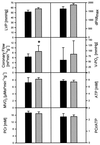Disruption of myoglobin in mice induces multiple compensatory mechanisms
- PMID: 10468637
- PMCID: PMC17917
- DOI: 10.1073/pnas.96.18.10495
Disruption of myoglobin in mice induces multiple compensatory mechanisms
Abstract
Myoglobin may serve a variety of functions in muscular oxygen supply, such as O(2) storage, facilitated O(2) diffusion, and myoglobin-mediated oxidative phosphorylation. We studied the functional consequences of a myoglobin deficiency on cardiac function by producing myoglobin-knockout (myo(-/-)) mice. To genetically inactivate the myoglobin gene, exon 2 encoding the heme binding site was deleted in embryonic stem cells via homologous recombination. Myo(-/-) mice are viable, fertile, and without any obvious signs of functional limitations. Hemoglobin concentrations were significantly elevated in myo(-/-) mice. Cardiac function and energetics were analyzed in isolated perfused hearts under resting conditions and during beta-adrenergic stimulation with dobutamine. Myo(-/-) hearts showed no alteration in contractile parameters either under basal conditions or after maximal beta-adrenergic stimulation (200 nM dobutamine). Tissue levels of ATP, phosphocreatine ((31)P-NMR), and myocardial O(2) consumption were not altered. However, coronary flow [6.4 +/- 1.3 ml.min(-1).g(-1) [wild-type (WT)] vs. 8.5 +/- 2.4 ml.min(-1).g(-1) [myo(-/-)] [and coronary reserve [17.1 +/- 2.1 (WT) vs. 20.8 +/- 1.1 (myo(-/-) ml. min(-1).g(-1) were significantly elevated in myo(-/-) hearts. Histological examination revealed that capillary density also was increased in myo(-/-) hearts [3,111 +/- 400 mm(-2) (WT) vs. 4,140 +/- 140 mm(-2) (Myo(-/-)]. These data demonstrate that disruption of myoglobin results in the activation of multiple compensatory mechanisms that steepen the pO(2) gradient and reduce the diffusion path length for O(2) between capillary and the mitochondria; this suggests that myoglobin normally is important for the delivery of oxygen.
Figures





Similar articles
-
Myoglobin-deficient mice activate a distinct cardiac gene expression program in response to isoproterenol-induced hypertrophy.Physiol Genomics. 2010 Apr 1;41(2):137-45. doi: 10.1152/physiolgenomics.90297.2008. Epub 2010 Feb 9. Physiol Genomics. 2010. PMID: 20145201
-
Oxygen supply and nitric oxide scavenging by myoglobin contribute to exercise endurance and cardiac function.FASEB J. 2005 Jun;19(8):1015-7. doi: 10.1096/fj.04-2886fje. Epub 2005 Apr 7. FASEB J. 2005. PMID: 15817640
-
Role of myoglobin in the antioxidant defense of the heart.FASEB J. 2004 Jul;18(10):1156-8. doi: 10.1096/fj.03-1382fje. Epub 2004 May 7. FASEB J. 2004. PMID: 15132981
-
Keeping the heart in balance: the functional interactions of myoglobin with nitrogen oxides.J Exp Biol. 2010 Aug 15;213(Pt 16):2726-33. doi: 10.1242/jeb.041681. J Exp Biol. 2010. PMID: 20675541 Review.
-
Life without myoglobin.Cell Mol Life Sci. 2000 Jun;57(6):896-8. doi: 10.1007/PL00000732. Cell Mol Life Sci. 2000. PMID: 10950305 Free PMC article. Review.
Cited by
-
Identification of two miRNAs regulating cardiomyocyte proliferation in an Antarctic icefish.iScience. 2024 May 27;27(6):110128. doi: 10.1016/j.isci.2024.110128. eCollection 2024 Jun 21. iScience. 2024. PMID: 38939105 Free PMC article.
-
Effects of nitric oxide donors on cardiac contractility in wild-type and myoglobin-deficient mice.Br J Pharmacol. 2002 Jun;136(3):415-20. doi: 10.1038/sj.bjp.0704740. Br J Pharmacol. 2002. PMID: 12023944 Free PMC article.
-
Characterization of oxygen radical formation mechanism at early cardiac ischemia.Cell Death Dis. 2013 Sep 5;4(9):e787. doi: 10.1038/cddis.2013.313. Cell Death Dis. 2013. PMID: 24008731 Free PMC article.
-
Myoglobin-derived iron causes wound enlargement and impaired regeneration in pressure injuries of muscle.Elife. 2023 Jun 2;12:e85633. doi: 10.7554/eLife.85633. Elife. 2023. PMID: 37267120 Free PMC article.
-
Endogenous myoglobin expression in mouse models of mammary carcinoma reduces hypoxia and metastasis in PyMT mice.Sci Rep. 2023 May 9;13(1):7530. doi: 10.1038/s41598-023-34614-w. Sci Rep. 2023. PMID: 37161046 Free PMC article.
References
-
- Wittenberg B A, Wittenberg J B. Annu Rev Physiol. 1989;51:857–878. - PubMed
-
- Millikan G A. Proc R Soc London Ser B. 1937;123:218–241.
-
- Wittenberg J B. Physiol Rev. 1970;50:559–636. - PubMed
-
- Wittenberg J B. Biol Bull. 1959;117:402.
-
- Wittenberg B A, Wittenberg J B. J Biol Chem. 1985;260:6548–6554. - PubMed
Publication types
MeSH terms
Substances
LinkOut - more resources
Full Text Sources
Molecular Biology Databases
Miscellaneous

